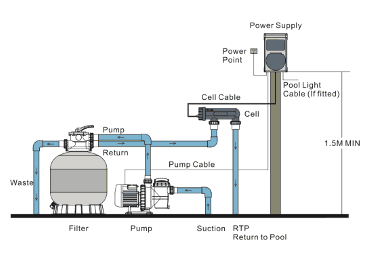- Last updated Oct 19, 2021
- Swimming Pool, Water Treatment
Salt Chlorinator
Introduction
Salt chlorinator converts sodium chloride (NaCl) into chlorine by electrolysis. Salt water is electrically charged, which breaks down the salt molecules and produces chlorine (Cl). A salt chlorinator contains two parts- the cell and the control board. The cell converts the salt into chlorine. Water passes through the cells and blades, which are coated with natural metals such as ruthenium or iridium. The cells are charged by the control board, which provides the electricity. The desired chlorine level can be set on the control board.
Working principle
As salt water travels through the swimming pool’s circulation system, it enters the salt chlorinator and passes through a salt cell. As the salt water flows through the cell, a low-voltage direct current is applied to flat, rectangular plates inside the cell, initiating electrolysis. Through electrolysis, salt and water break up into hydrogen gas and hypochlorous acid. The hydrogen gas simply leaves the swimming pool water in the form of small bubbles. The hypochlorous acid sanitizes the swimming pool water and ultimately reverts back into salt, and the process repeats.
2NaCl + 2H2O = 2NaOH + H2↑ + Cl2↑
Cl2 + 2NaOH = NaCl + NaClO + H2O

Working Condition
Environment Temperature: 0 °C to 50 °C. (Varies depending on model)
- Humidity: ≦ 85%
- Installation Area must be with good ventilation
- Keep away from other heat source
Sizing of salt chlorinator
Chlorine Level Calculation
Required Chlorine Production Rate (g/hr) = (Pool volume(litre) × Standard chlorine (g/litre))/turn over rate(hr)
Standard Chlorine Level not less than 2mg/litre = 0.002g/liter or 2 PPM
Example:
Pool Volume: 65 m3 = 65,000 liter
Turnover Rate: 4 hours
Required Chlorine Production Rate (g/hr) = (65,000 litre X 0.002 g/litre)/ 4 hours
Required Chlorine Production Rate (g/hr) = 32.5 g/hr
Therefor a pool with 65 m3 pool volume and with 4 hour turnover rate, require a chlorinator having a minimum production rate of 32.5 g/hr